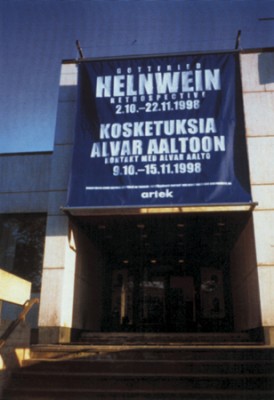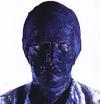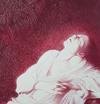Press and Media
Turun Sanomat, Finland – October 2, 1998
Wäinö Aaltonen Museum of Art, Turku, Finland, 1998
GOTTFRIED HELNWEIN IN TURKU, - "I ASK, I DO NOT ANSWER."
"I ask, I do not answer." - My works are questions, not answers, says the Austrian, Gottfried Helnwein, time and time again focusing on the most sore points of contemporary, general and private history.

The retrospective exhibition of this controversial artist was opened yesterday in Wäinö Aaltonen Museum of Art and is open until 22nd of November. Helnwein says he became an artist because, being born after the war, he had so many questions to ask. He also stresses that the same questions must be asked again and again.
"I, as probably every artist does, have only one theme which I incessantly vary. The use of diverse techniques is but a means of getting closer to one's original goals.
"I always start to make a new picture to get closer to what I want to say. Now I'm learning to use Internet technology", says Helnwein who began as a painter.
Wounded Children
Helnwein, born in 1948, made his first painting in 1969. The earliest works included in the Turku exhibition are from the early seventies. The almost photorealistically accurate watercolours present the artist's central themes, injured and wounded children.
"The first 8-9 years I painted only children. I was surprised by the strong reactions and rejection they provoked.
"After the war everyone was depressed and gloomy. Until the sixties the Austrians were unable to speak of the war and deal with its problematics."
One of Helnwein's permanent themes is violence and the Nazi era of Austria and Germany.
"Considering the continuum of time, the Nazi days are a kind of crystallisation of evil and foolishness. Unfortunately nothing has changed, the same things still happen all over"; Helnwein says and reminds that in Germany alone thousands of children are abused to death every year.
Incest, pedophiles, the scorn for difference and minorities and senseless violence are not limited to any country, nation or period of time.
Striving for Dialogue
While Helnwein's works are open to any questions, they also are an attempt at dialogue.
"I would never make any work of art only for myself. Neither will I ever make art for connoisseurs, but to everyone." According to Helnwein, offset-printing technique in a way gives the ultimate means to making art.
"I like posters and magazines. It is completely bizarre that these magazines are used as vehicles for selling toilet paper or candy, even though they can be used to spread any visual messages to millions of people. "
Helnwein reminds that in art there are at least as much regulations and rules as in any other system. To rebel against all this Helnwein has quit having exhibitions in the seventies and concentrated to utilise the possibilities of so-called lowbrow art. One of the most successful channels was the cover images of magazines.
"Although my pictures have been published in magazines throughout the world, many of my ideas have been rejected or forbidden during the years", Helnwein reminds. He has also made numerous provoking posters for theatre productions. "It is fascinating to epitomise a two-hour performance into a single picture, which has to tell everything essential."
Against Colours and Images
Helnwein's photographs are black and white and the paintings often operate with only one or two colours. The choice is conscious.
"In the eighties I wanted to return to conventional expression, but with only one colour. There are far too many images and colours in the world. The artist must oppose to this overload."
Many paintings are based on a photo, which the artist has operated on my painting, drawing or computer technology. Thus an originally realistic, representative image has mutated into something completely different.
"I always work on multiple images at the same time. The titles of the works never explain the contents, they are only an extra element. Sometimes a finished work has to wait a long time for an appropriate title."
Grotesque Self Portraits
The basic theme of Helnwein is the oppressed and subdued human being. After bandaged children he has made a number of extremely grotesque self portraits, whose anonymous, alienated model has his eyes, ears and mouth covered or filled with different surgical instruments.
"As a child I dreamed of becoming a doctor. In my later works I have found a new way to use medical instruments, which were originally meant for helping people. "
In the exhibition there are also a vast number of almost naturalistic photos of celebrities who have been elevated to the status of myths. Helnwein says he himself was amazed by how Bukowski or Warhol looked in the photos. "In reality they looked perfectly normal", Helnwein says. Surprisingly he finds similarities in the facial traits of Donald Duck and his creator, Carl Barks.
Mickey and Madonna
Amid the paintings, two are distinctive: Mickey and Duck, made a couple of years ago.
"The Mickey Mouse comics opened a new world for me in my dark and desolate childhood."
The Mickey by the grown-up Helnwein is not a harmless little mouse, but a cruelly grinning beast, by which the artist refers to the Disney entertainment empire. One of the things affecting the gloom and desolation of his childhood was the narrow-minded religiosity of his family. This is a theme Helnwein examines in his newest Madonna-themed works, which are present in Turku in a small but enlightened selection.
Gottfried Helnwein, Wäinö Aaltonen Museum of Art, Turku, Finland
02.Oct.1998 Turun Sanomat, Finland. Kimmo Lilja


